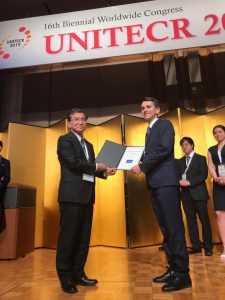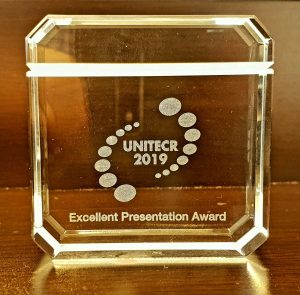Robert in Orleans, France
Spring 2019 – Objective: High temperature Brazilian test coupled with digital image correlation method
I had a unique opportunity to complete 3 month secondment at the Polytech Orleans. I am grateful to Lucas Teixeira, Jean Gillibert and Eric Blond for their hospitality and commitment to work on a common goal.
Our goal was to improve a device for high temperature Brazilian test with simultaneous acquisition of visible light images. Capturing images at these conditions require several precautions to take. First of all, in order to use digital image correlation (for calculations of displacement and deformation), we needed to cover observed specimen’s surface with high temperature resistant speckle pattern. The main concerns related to this pattern are its contrast with specimen and stability at investigated temperature. Secondly, materials observed at 900-1500°C emit red light (see: black body radiation), which significantly reduces contrast of observed speckle pattern. Another important issue is heat haze (change of refractive index due to irregular flow of cold/hot air) between investigated specimen and camera. During my secondment, we significantly reduced the influence of these three issues and we succeed to acquire clean images at high temperature.
Another topic was the design of loading pieces for the Brazilian test. As there is no standard for Brazilian tests on refractory materials, the shape and dimensions of loading pieces were determined, basing on bibliographical research (concerning experiments on various materials and simulated results).
Once our image acquisition system and loading device were operational, we performed a series of fracture tests. Then, results were post-treated using the DIC and 2P-DIC pieces of software developed by Jean-Christophe Dupré and Pascal Doumalin (University of Poitiers).
I already had pleasure to present a part of obtained results at the UNITECR 2019 (16th Biennial Worldwide Congress Unified International Technical Conference on Refractories) in Yokohama, Japan and to win the Excellent Presentation Poster Award there. I believe that the results, which I acquired during my secondment, helped me to get this award.
I am really happy to be a part of the European project ATHOR, which opens many doors – in this case opportunity to perform research at the Polytech Orleans. Taking advantage of the new working environment, I enjoyed leisure time with other researchers, during which we visited e.g. the Castles of the Loire Valley.
from the European Union's Horizon 2020 research and innovation program under grant
agreement no.764987


